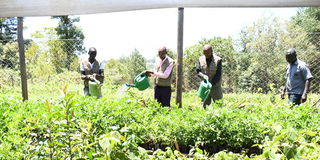How ordinary villagers transformed 90 hectares of devastated woodland into a thriving ecosystem

Community conservation champions watering seedlings in the Ndoinet Forest Nursery in the larger South West Mau ecosystem in Kuresoi South, Nakuru County.
What you need to know:
- Local champions in Kuresoi South have transformed the once-degraded Ndoinet Forest, rehabilitating over 90 hectares through community-led conservation efforts.
- They've established tree nurseries, engaged schools, and implemented protective measures that have restored water sources and biodiversity.
The once-majestic Ndoinet Forest stood on the brink of collapse. Its towering indigenous trees had fallen silent to the relentless buzz of illegal chainsaws. Water sources vanished. Soil washed away with each rainfall. But in Kuresoi South Constituency, a quiet revolution was brewing—one seedling at a time.
"For years, we saw our forest being destroyed and bore the brunt of the consequences," says Leonard Rotich, gazing across what was once barren land, now sprouting with new life.
"Instead of waiting for external intervention, we took action ourselves."
This remarkable environmental transformation epitomises the power of community action in the face of ecological crisis.
From bystanders to guardians
The South West Mau ecosystem, which includes Ndoinet Forest, had suffered years of illegal logging, charcoal burning, and encroachment. The consequences were dire—vanishing water sources, accelerating soil erosion, and increasingly unpredictable climate patterns that threatened local livelihoods.
In 2018, five concerned residents decided they'd seen enough. Under Rotich's leadership, they mobilised neighbours and formed a community conservation group that quickly grew to 15 members.
"We started by marking the degraded sections of the forest before planting seedlings and transferring them to the affected areas," explains Rotich, who chairs the conservation group.
"Now we have rehabilitated more than 90 hectares."
Today, Ndoinet Forest is divided into 13 sections, each under the watchful eye of a community champion who works in close collaboration with the Community Forest Association (CFA) and the Kenya Forest Service (KFS).

Newly planted trees at Tirgoi, a section of Ndoinet Forest.
The road to restoration wasn't always smooth. Many locals initially resisted conservation efforts, as their livelihoods depended on forest resources.
"At first, residents were resistant as many relied on the forest for charcoal and timber," admits David Langat, one of the dedicated community champions. "But through continuous sensitisation, many now understand the long-term benefits of conservation."
Langat passionately explains the forest's vital role in maintaining biodiversity and regulating climate patterns. He notes that years of deforestation had severely disrupted the water cycle, leading to more frequent droughts and dwindling water sources throughout the region.
Recognising these threats, the community launched an ambitious reforestation initiative focused on native tree species that would restore both soil health and water balance.
Nurturing the next generation
Understanding that sustainable conservation requires intergenerational commitment, the champions have incorporated schools into their restoration efforts.
Monthly conservation outreach programs now reach 34 schools within a five-kilometre radius of the forest, engaging students directly in tree planting and practical conservation activities.
"We engage students in tree planting and conservation practices," Langat explains.
"We have also introduced energy-saving jikos, which we supply to schools to reduce firewood demand."
This dual approach—rebuilding the forest while reducing resource pressure—has proven particularly effective.
Community-led ecosystem
The grassroots effort has grown into a robust conservation ecosystem. Jackson Keter, deputy secretary of Ndoinet CFA, reports that the group has established a tree nursery housing 40,000 seedlings of various species, ensuring biodiversity-friendly reforestation while creating sustainable livelihoods.
Rhino Ark Charitable Trust has provided crucial support to these community-led initiatives. Bernard Kibet, a field officer with the organization, details their systematic approach to forest rehabilitation since 2018.
"We started with 40 hectares in Kipkoris section in 2018, followed by 10 hectares in Kapkembu in 2021, 30 hectares in Korabariet in 2022 and another 70 hectares in Tirgoi between 2022 and 2023," Kibet explains.
In total, Rhino Ark has helped rehabilitate 150 hectares across different sections of the forest, working hand-in-hand with community champions and CFAs.
Protecting gains
The reforested areas have since been entrusted to KFS for continuous monitoring and protection. Ndoinet Forest Assistant Forester Toroitich Yego explains that the forest is now divided into six security sections, each manned by four rangers to enhance protection and conservation efforts.
Additionally, Rhino Ark has established a joint surveillance program where eight dedicated scouts accompany KFS rangers on daily patrols throughout the forest.
"The surveillance unit plays a crucial role in deterring illegal activities and ensuring the restored areas remain protected," adds Kibet.
Model for success
The Ndoinet restoration initiative is now serving as an inspiration for other communities battling deforestation across Kenya. With water sources recovering and biodiversity rebounding, this forest stands as living proof that local action and cross-sector collaboration can heal even the most damaged landscapes.
As Rotich proudly observes: "We are seeing results—our forest is recovering, water sources are replenishing and our community understands the value of conservation."


